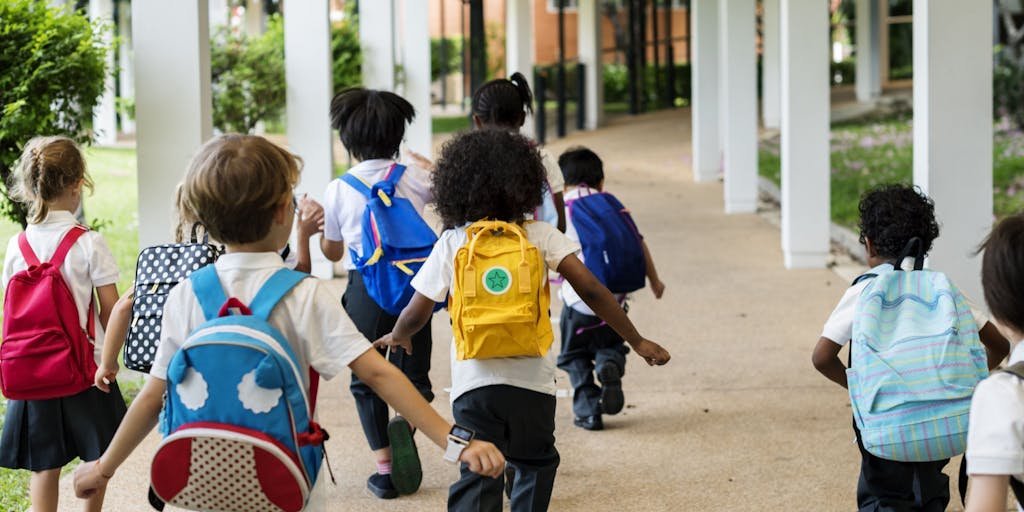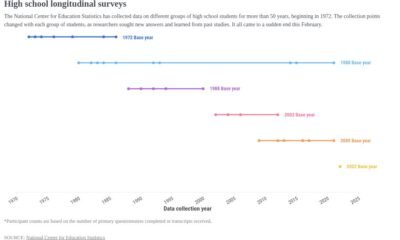Education
A gender gap in STEM widened during the pandemic. Schools are trying to make up lost ground

IRVING, Texas — Crowded around a workshop table, four girls at de Zavala Middle School puzzled over a Lego machine they had built. As they flashed a purple card in front of a light sensor, nothing happened.
The teacher at the Dallas-area school had emphasized that in the building process, there are no such thing as mistakes. Only iterations. So the girls dug back into the box of blocks and pulled out an orange card. They held it over the sensor and the machine kicked into motion.
“Oh! Oh, it reacts differently to different colors,” said sixth grader Sofia Cruz.
In de Zavala’s first year as a choice school focused on science, technology, engineering and math, the school recruited a sixth grade class that’s half girls. School leaders are hoping the girls will stick with STEM fields. In de Zavala’s higher grades — whose students joined before it was a STEM school — some elective STEM classes have just one girl enrolled.
Efforts to close the gap between boys and girls in STEM classes are picking up after losing steam nationwide during the chaos of the Covid pandemic. Schools have extensive work ahead to make up for the ground girls lost, in both interest and performance.
In the years leading up to the pandemic, the gender gap nearly closed. But within a few years, girls lost all the ground they had gained in math test scores over the previous decade, according to an Associated Press analysis. While boys’ scores also suffered during Covid, they have recovered faster than girls, widening the gender gap.
As learning went online, special programs to engage girls lapsed — and schools were slow to restart them. Zoom school also emphasized rote learning, a technique based on repetition that some experts believe may favor boys, instead of teaching students to solve problems in different ways, which may benefit girls.
Old practices and biases likely reemerged during the pandemic, said Michelle Stie, a vice president at the National Math and Science Initiative.
“Let’s just call it what it is,” Stie said. “When society is disrupted, you fall back into bad patterns.”
Related: A lot goes on in classrooms from kindergarten to high school. Keep up with our free weekly newsletter on K-12 education.
In most school districts in the 2008-09 school year, boys had higher average math scores on standardized tests than girls, according to AP’s analysis, which looked at scores across 15 years in over 5,000 school districts. It was based on average test scores for third through eighth graders in 33 states, compiled by the Educational Opportunity Project at Stanford University.
A decade later, girls had not only caught up, they were ahead: Slightly more than half of districts had higher math averages for girls.
Within a few years of the pandemic, the parity disappeared. In 2023-24, boys on average outscored girls in math in nearly 9 out of 10 districts.
A separate study by NWEA, an education research company, found gaps between boys and girls in science and math on national assessments went from being practically non-existent in 2019 to favoring boys around 2022.
Studies have indicated girls reported higher levels of anxiety and depression during the pandemic, plus more caretaking burdens than boys, but the dip in academic performance did not appear outside STEM. Girls outperformed boys in reading in nearly every district nationwide before the pandemic and continued to do so afterward.
“It wasn’t something like Covid happened and girls just fell apart,” said Megan Kuhfeld, one of the authors of the NWEA study.
Related: These districts are bucking the national math slump
In the years leading up to the pandemic, teaching practices shifted to deemphasize speed, competition and rote memorization. Through new curriculum standards, schools moved toward research-backed methods that emphasized how to think flexibly to solve problems and how to tackle numeric problems conceptually.
Educators also promoted participation in STEM subjects and programs that boosted girls’ confidence, including extracurriculars that emphasized hands-on learning and connected abstract concepts to real-life applications.
When STEM courses had large male enrollment, Superintendent Kenny Rodrequez noticed girls losing interest as boys dominated classroom discussions at his schools in Grandview C-4 District outside Kansas City. Girls were significantly more engaged after the district moved some of its introductory hands-on STEM curriculum to the lower grade levels and balanced classes by gender, he said.
When schools closed for the pandemic, the district had to focus on making remote learning work. When in-person classes resumed, some of the teachers had left, and new ones had to be trained in the curriculum, Rodrequez said.
“Whenever there’s crisis, we go back to what we knew,” Rodrequez said.
Related: One state tried algebra for all eighth graders. It hasn’t gone well
Despite shifts in societal perceptions, a bias against girls persists in science and math subjects, according to teachers, administrators and advocates. It becomes a message girls can internalize about their own abilities, they say, even at a very young age.
In his third grade classroom in Washington, D.C., teacher Raphael Bonhomme starts the year with an exercise where students break down what makes up their identity. Rarely do the girls describe themselves as good at math. Already, some say they are “not a math person.”
“I’m like, you’re 8 years old,” he said. “What are you talking about, ‘I’m not a math person?’”
Girls also may have been more sensitive to changes in instructional methods spurred by the pandemic, said Janine Remillard, a math education professor at the University of Pennsylvania. Research has found girls tend to prefer learning things that are connected to real-life examples, while boys generally do better in a competitive environment.
“What teachers told me during Covid is the first thing to go were all of these sense-making processes,” she said.
Related: OPINION: Everyone can be a math person but first we have to make math instruction more inclusive
At de Zavala Middle School in Irving, the STEM program is part of a push that aims to build curiosity, resilience and problem-solving across subjects.
Coming out of the pandemic, Irving schools had to make a renewed investment in training for teachers, said Erin O’Connor, a STEM and innovation specialist there.
The district last year also piloted a new science curriculum from Lego Education. The lesson involving the machine at de Zavala, for example, had students learn about kinetic energy. Fifth graders learned about genetics by building dinosaurs and their offspring with Lego blocks, identifying shared traits.
“It is just rebuilding the culture of, we want to build critical thinkers and problem solvers,” O’Connor said.
Teacher Tenisha Willis recently led second graders at Irving’s Townley Elementary School through building a machine that would push blocks into a container. She knelt next to three girls who were struggling.
They tried to add a plank to the wheeled body of the machine, but the blocks didn’t move enough. One girl grew frustrated, but Willis was patient. She asked what else they could try, whether they could flip some parts around. The girls ran the machine again. This time, it worked.
“Sometimes we can’t give up,” Willis said. “Sometimes we already have a solution. We just have to adjust it a little bit.”
Lurye reported from Philadelphia. Todd Feathers contributed reporting from New York.
The Associated Press’ education coverage receives financial support from multiple private foundations. AP is solely responsible for all content. Find AP’s standards for working with philanthropies, a list of supporters and funded coverage areas at AP.org.
Education
The Impact of AI on Education: How ChatGPT and Other Tools Are Changing Learning

Artificial intelligence can become a tool in the development of education, in particular, to help create individual learning paths for Ukrainian students, but it is important to be aware of the risks of its incorrect use. Yevhen Kudriavets, First Deputy Minister of Education and Science, told UNN correspondent about this.
Details
“I think that first of all, we should say that any technology definitely contributes to the development of systems, including the educational system. But the question is how we will use it, positively or negatively. Positively, artificial intelligence can definitely help analyze a lot of information and get exactly what you need at the moment to acquire knowledge. But at the same time, the advantage that intelligence gives is that it can help build individual educational trajectories faster than a teacher would do it separately. Because we understand that, for example, for 3.5 million students in Ukraine, an individual trajectory is needed for everyone,” Kudriavets said.
According to him, today it is difficult to build with human efforts, but artificial intelligence can help with this.
Most employees in Ukraine regularly use AI in their work
06.06.25, 18:17 • 2947 views
“Of course, there are downsides, negative aspects. This includes the issue of ethical use of artificial intelligence, so that it does not directly replace the educational process. And here we just need to look for ways to combat and resolve this,” Kudriavets added.
He emphasized that schoolchildren themselves must understand why they need to use artificial intelligence.
“It seems to me that they can still give us advice on how to use artificial intelligence correctly. But the key is to answer the question of why and for what purpose I am using it. That is, it is not about prohibiting or giving some rules on how to use it. It is about why, because if you have a goal, and you do not use this research after that for this goal, you achieve your goal, great. If you cheat and deceive, and as a result your goal is to get a grade and not get knowledge, then of course, you will not achieve your goal in getting an education,” Kudriavets emphasized.
AI assistant launched on Diia portal in Ukraine01.09.25, 16:37 • 2337 views
Education
David Bong, CEO & co-founder of Avant Assessment

Introduce yourself in three words or phrases.
Innovative, empathetic, determined
What do you like most about your job?
Every day brings a new experience with a language or language community in the US or somewhere else in the world for the 150 languages we assess. It never gets old exploring creative ways to expand opportunities for learners, teachers, and test-takers through innovative assessment, learning technologies, and pedagogies.
Best work trip/Worst work trip?
Best: This June, I attended EdTech Week in London – a full week of thought-provoking sessions on how entrepreneurs are reshaping learning and teaching. Conversations with fellow innovators from all over the world, including The PIE’s own CEO Amy Baker, sparked countless ideas for growing our services. The weather was glorious, and staying on London’s vibrant East Side showed me a whole new incredibly rich and diverse face of the city.
Worst: I’ve had a few challenging trips, but I genuinely love travel. Even the tough ones offer valuable lessons.
If you could learn a language instantly, which would you pick and why?
Brazilian Portuguese – it feels like the voice is dancing with every word. It’s such a contrast to my second language, Japanese, which I deeply love. It would be wonderful to have the ability to speak two such different and beautiful languages. Brazil’s fast-growing economy and strong demand for both English and Spanish learning and assessment make Portuguese not only beautiful, but strategically valuable for business.
What makes you get up in the morning?
Our remarkable global team. They amaze and inspire me every day.
Champion/cheerleader which we should all follow and why?
In a world without many inspiring political leaders, I admire the courage, determination, and leadership of Volodymyr Zelensky. As far as a leader in reporting on technology and how it impacts global society, business, and education: Azeem Azhar consistently provides the most insightful analysis I have found.
Worst conference food/beverage experience
I won’t comment on the worst, but if I could humbly say, the best was the spread of Polish food our company put on for our party at the Polish Museum of America in Chicago during the US national language conference in 2023.
Book or podcast recommendation for others in the sector?
AI is the biggest topic out there everywhere, including EdTech. Although it was written before ChatGPT exploded on the scene, I found this book incredibly helpful in understanding both the fundamental principles of AI, and the history of how it has evolved since it was first discussed in 1954 at Dartmouth College. ‘Artificial Intelligence: A Guide for Thinking Humans’ by Melanie Mitchell. As a history major in college learning the context of where it started to where it is today gave me a good feel for the trajectory of this powerful technology.
A classic book on EdTech I would recommend is Clayton Christensen’s 2008 book ‘Disrupting Class: How Disruptive Innovation Will Change the Way the World Learns’. A personal lesson for me from the book: even proven technologies take years to gain traction in education, and that the change will only come from around the margins. As the developer of ELPA in 2004, the first online test of English for English Language Learners for the Oregon Department of Education, we assumed that departments across the US would quickly adopt online testing given the many advantages that it provided. Instead, it took the Covid crisis to finally push online testing to be used throughout the US education system.
Describe a project or initiative you’re currently working on that excites you.
In 2022 we created Mira, our AI-powered language learning and assessment platform. This summer we launched Mira Stride, a formative assessment that uses AI to instantly analyae English Language learners’ use of language, provide individualised reports on the strengths and challenges for the learners, and identify concrete measures that teachers can use to address each learner’s challenges. I am constantly amazed by the power of properly harnessed AI technologies to personalise and accelerate language learning.
Education
How Schools Are Helping Students Feel Safe Enough to Attend Class Amid Immigration Raids

From parents’ fraught decisions over whether they can safely send their children to class to reports of districts losing families to self-deportation, schools around the country are responding to the ripple effects touched off by the Trump administration’s aggressive immigration raids.
More specifically, they are trying to counteract the resulting fear that’s keeping students away from campuses — a continuation of what they saw in the spring as the immigration authorities ramped up apprehensions and deportations. Estimates put the number of K-12 students who did not have legal status in the U.S. at roughly 620,000 in 2021, about 1 percent of public school students.
Since the start of this new school year, education leaders and immigration advocacy groups have highlighted the challenges that schools and families are facing in light of ICE sweeps in their communities. Anxiety is higher following a recent Supreme Court decision allowing federal agents in Los Angeles to question people about their immigration status based solely on factors like their race, ethnicity or language spoken.
Speakers during recent panels hosted by America’s Voice and Advancement Project, an immigrants’ and civil rights organization, respectively, discussed what they believe should be schools’ role in ensuring parents and students feel safe.
The Effects of Fear
Fear caused by the visibility of immigration apprehensions can impact any child, clinical child psychologist Allison Bassett Ratto said during an America’s Voice panel, but immigrant children in particular are facing psychological harm. The resulting stress and trauma could be short- or long-term, she adds, and they can develop conditions like post-traumatic stress disorder whether they witness violence directly in person, or online.
“What they see are their classmates, their family members, their neighbors often being apprehended in violent and confusing ways while going about their daily lives, and this for children creates a sense that nowhere and no one is safe,” Bassett Ratto said. “Young children don’t understand who is at risk of being detained in this way, so this creates a sense of fear and worry that they or their families could be next.”
Noel Candelaria, the National Education Association’s secretary-treasurer and a special education teacher, said that children of immigrant parents feel unsafe in their own communities and “unsure of who they will find or not find when they get home from school.”
“Every student, cada estudiante, deserves to feel safe at school,” Candelaria said.
Alberto Carvalho, superintendent of the Los Angeles Unified School District, feels a personal connection to the issue. He’s spoken publicly about his experience living without legal status in the U.S. after graduating high school in his native Portugal. He was homeless in Miami for a time, eventually becoming a teacher and later superintendent of the Miami-Dade school district.
“As a once-undocumented immigrant, as someone who grew up in poverty and slept under a bridge, I cannot speak or address anyone without recognizing the impact that education has had on my life and that thousands of students are facing the same challenges and the same traumatic abuse I felt as a teenager alone in this country,” Carvalho said. “We are asserting the fundamental rights that belong to our children as prescribed and interpreted in the Constitution.”
Researchers have found that stress can impede normal childhood development, and instability like that caused by the Trump administration’s current immigration policies can interfere with children’s ability to focus and learn while in school.
“What we see in terms of school impacts is that when a child is managing trauma, anxiety or intense stress, it significantly impacts their ability to pay attention because that is like a vice on their brain,” Bassett Ratto said. “Fundamentally, it puts them in this fight or flight, the survival mode where math class or their band instructor is unfortunately moving to the back burner as they try and just get through their day over the long term.”
Fedrick Ingram, the American Federation of Teachers’ secretary-treasurer and a high school band director in Miami, described feeling a dissonance between the fear caused by immigration arrests and the normalcy of the school day.
“Unfortunately, we’re up against what we’ve not seen in the country in a long time, where we are traumatizing students and then asking them to go home and do school work in a traumatized situation,” Ingram said. “What many of our lawmakers have done is point fingers at our educators, point fingers at our students and say, ‘You didn’t pass this test,’ or ‘You didn’t do enough.’ They fail to understand these kids will bring those traumas to school and try to do the best they can, and we’re forcing them to try to process these things faster than they should, so shame on this administration.”
Attendance Struggles
Schools have a responsibility to protect students that goes beyond ensuring they can safely get into the building, Kristal Moore Clemons said. She is national director of the Children Defense Fund’s Freedom Schools program.
“This means superintendents, principals, school board members must establish clear procedures for how their staff should respond if ICE agents appear on school grounds,” she said during the Advancement Project panel. “This means taking the time to teach all students in all districts what their rights are if they are ever approached or questioned by immigration officials.”
Carvalho said that Los Angeles public schools have seen a slight enrollment dip, but concrete numbers on attendance won’t be available until mid-month. Prior to the school year’s start, he added, the district went on a communication blitz to reassure parents their children would be safe while en route to and inside their schools. The effort included adding more bus routes, increasing the number of mental health and legal aid professionals available to families, and helping parents understand their rights in case of an encounter with immigration agents.
“We prevented DHS agents from coming into our schools to talk to a first grader and second grader. What danger do elementary kids pose to national security?” he said. “I hope the community feels from us that we are that protective space, that our schools are those safe zones.”
Ingram noted that Miami-Dade County Public Schools saw enrollment drop by more than 13,000 students this fall, the result of not only immigration policy but also declining birth rates and families leaving for more affordable locales. The superintendent has promised not to lay off teachers as a result of any funding shortfalls.
“While we can’t attribute all of that to the immigration fight, we know that there’s a significant portion of people who are just not sending their students to school because of fear of deportation, because of fear of what will happen at home or because of tracing or what have you,” he said. “Where those dollar figures add up is there are fewer teachers, there are fewer programs and there’s less funding for students overall. And so anytime you get this particular kind of issue or this particular kind of trauma and stress to a school system, it hurts everybody from top to bottom.”
Adaku Onyeka-Crawford, director of the Opportunity to Learn Program at Advancement Project, said during a panel hosted by her organization that she’s seen families in the Washington, D.C., area show support by walking students to school in groups.
“They walk together to school to make sure that they get to school safely and aren’t afraid of being stopped or detained while just going to school,” Onyeka-Crawford said. “However, we don’t see that commitment coming from district leadership. We want them to make sure that these resources are available to all students, because we are just seeing that parents and school leadership need that support from the district and aren’t receiving it.”
-

 Business2 weeks ago
Business2 weeks agoThe Guardian view on Trump and the Fed: independence is no substitute for accountability | Editorial
-
Tools & Platforms1 month ago
Building Trust in Military AI Starts with Opening the Black Box – War on the Rocks
-

 Ethics & Policy2 months ago
Ethics & Policy2 months agoSDAIA Supports Saudi Arabia’s Leadership in Shaping Global AI Ethics, Policy, and Research – وكالة الأنباء السعودية
-

 Events & Conferences4 months ago
Events & Conferences4 months agoJourney to 1000 models: Scaling Instagram’s recommendation system
-

 Jobs & Careers2 months ago
Jobs & Careers2 months agoMumbai-based Perplexity Alternative Has 60k+ Users Without Funding
-

 Podcasts & Talks2 months ago
Podcasts & Talks2 months agoHappy 4th of July! 🎆 Made with Veo 3 in Gemini
-

 Education2 months ago
Education2 months agoMacron says UK and France have duty to tackle illegal migration ‘with humanity, solidarity and firmness’ – UK politics live | Politics
-

 Education2 months ago
Education2 months agoVEX Robotics launches AI-powered classroom robotics system
-

 Funding & Business2 months ago
Funding & Business2 months agoKayak and Expedia race to build AI travel agents that turn social posts into itineraries
-

 Podcasts & Talks2 months ago
Podcasts & Talks2 months agoOpenAI 🤝 @teamganassi



















